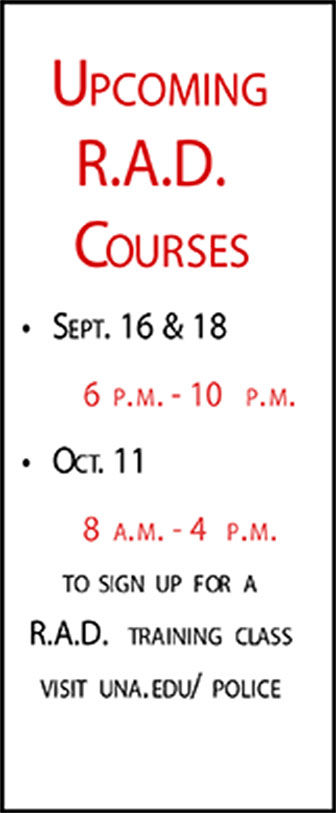Free self-defense class receives low turn out
September 4, 2014
Though UNA’s campus has had a number of sexual assaults in the past few years, the annual self-defense training course has not seen an increase in attendance.
“The mission of the R.A.D. Systems is to establish an accessible, constantly improving and internationally respected alliance of dedicated instructors,” according to the program’s website.
Rape Aggression Defense or R.A.D., training is a national standard self-defense program, specifically for women, that provides the skills and confidence to avoid and confront individuals who may attempt to hurt them, said Bob Pastula, chief of police.
“I just thought it was something we could use — a program where the women could learn how to defend themselves against male attackers,” Pastula said. “It’s a national standard program.”
Officer Shequanda Jenkins, sexual assault investigator and R.A.D. instructor, said the likelihood of women being attacked or assaulted goes down after completing the R.A.D. training.
“The program is geared toward anybody that’s interested in self-defense as long as they’re female,” Jenkins said. “My youngest student has been 15, my oldest student was 86.”
The police department also offers trainings for different groups on campus.
“We give special (classes) to special groups,” Pastula said. “We give it to the residence halls as part of their regular training. We’ve even offered them key chains with pepper spray on it.”
Attendance for the training program has been very low since the course was implemented in 2011, Pastula said.
Jenkins conducted her training at the University of Florida when Pastula created the program.
“The attendance is very, very low,” Jenkins said. “We usually have 16-25 people sign up every class and then we get to the class and we may have six to eight.”
Attendance is higher among community members than students, Pastula said.
“I’d like to have all the females at the university attend it — faculty, staff, students — everybody,” Pastula said.
Jenkins said she thinks one reason most students do not attend the course is because of the length of the class.
“I think it’s hard for people to commit to the time to do the program,” Jenkins said. “I think that’s the biggest thing.”
Sophomore Kaydee Jones said she would consider taking the class if the hours were shorter.
“I work part-time so there’s no time I could do a whole eight hours,” Jones said. “I would be more likely to take the four-hour, but still, that’s an extremely long amount of time.”
Jenkins said she is open to suggestions from students.
“We could break it down,” Jenkins said. “If we get enough people together, and we have 10 people committed, we can break it down to two-hour classes, three-hour classes, whatever will work for someone’s schedule.”
By offering a half-credit hour, changing how the class is done, and keeping the class free, Jenkins is hopeful attendance will rise, she said.
Though it’s a class only for women, junior Michael Fitzsimmons said he thinks the class is a good idea.
“I believe it’s a good step toward helping women be able to think of a situation that could happen and be able to think of a way to get out of it,” Fitzsimmons said.












